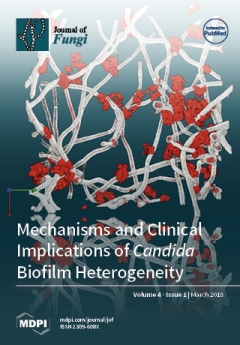Clinically relevant members of the fungal genus,
Fusarium, exhibit an extraordinary genetic diversity and cause a wide spectrum of infections in both healthy individuals and immunocompromised patients. Generally,
Fusarium species are intrinsically resistant to all systemic antifungals. We investigated whether the presence
[...] Read more.
Clinically relevant members of the fungal genus,
Fusarium, exhibit an extraordinary genetic diversity and cause a wide spectrum of infections in both healthy individuals and immunocompromised patients. Generally,
Fusarium species are intrinsically resistant to all systemic antifungals. We investigated whether the presence or absence of the ability to produce biofilms across and within
Fusarium species complexes is linked to higher resistance against antifungals. A collection of 41
Fusarium strains, obtained from 38 patients with superficial and systemic infections, and three infected crops, were tested, including 25 species within the
Fusarium fujikuroi species complex, 14 from the
Fusarium solani species complex (FSSC), one
Fusarium dimerum species complex, and one
Fusarium oxysporum species complex isolate. Of all isolates tested, only seven strains from two species of FSSC, five
F.
petroliphilum and two
F.
keratoplasticum strains, recovered from blood, nail scrapings, and nasal biopsy samples, could produce biofilms under the tested conditions. In the liquid culture tested, sessile biofilm-forming
Fusarium strains exhibited elevated minimum inhibitory concentrations (MICs) for amphotericin B, voriconazole, and posaconazole, compared to their planktonic counterparts, indicating that the ability to form biofilm may significantly increase resistance. Collectively, this suggests that once a surface adherent biofilm has been established, therapies designed to kill planktonic cells of
Fusarium are ineffective.
Full article






